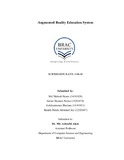| dc.contributor.advisor | Alam, Dr. Md. Ashraful | |
| dc.contributor.author | Hasan, Md. Mehedi | |
| dc.contributor.author | Faiyaz, Intisar Hasnain | |
| dc.contributor.author | Bhuiyan, Ashikuzzaman | |
| dc.contributor.author | Joy, Sheakh Fahim Ahmmed | |
| dc.date.accessioned | 2018-11-14T10:38:46Z | |
| dc.date.available | 2018-11-14T10:38:46Z | |
| dc.date.copyright | 2018 | |
| dc.date.issued | 8/3/2018 | |
| dc.identifier.other | ID 14101028 | |
| dc.identifier.other | ID 13201079 | |
| dc.identifier.other | ID 14101021 | |
| dc.identifier.other | ID 12201047 | |
| dc.identifier.uri | http://hdl.handle.net/10361/10849 | |
| dc.description | This thesis is submitted in partial fulfilment of the requirements for the degree of Bachelor of Science in Computer Science and Engineering, 2018. | |
| dc.description | Includes bibliographical references (pages 33-34). | |
| dc.description | Cataloged from PDF version of thesis. | en_US |
| dc.description.abstract | Technology in education can influence students to learn with enthusiasm and can
motivate them, leading to an effective process of learning. Researchers have identified
the problem that technology will create a passive learning process if the technology
used does not promote critical thinking, meaning-making or metacognition. Since its
introduction, augmented reality (AR) has been shown to have good potential in making
the learning process more active, effective and meaningful. This is because its advanced
technology enables users to interact with virtual and real-time applications and brings
the natural experiences to the user. In addition, the merging of AR with education has
recently attracted research attention because of its ability to allow students to be
immersed in realistic experiences. Therefore, this thesis paper is based on the research
that has been conducted on AR. The review describes the application of AR on primary
education using individual “topic cards” for different topics of primary school syllabus.
The review of the results of the research shows that, overall, AR technologies have a
positive result and potentiality that can be adapted in education. The review also
indicates the advantages and limitations of AR which could be addressed in future
research. | en_US |
| dc.description.statementofresponsibility | Md. Mehedi Hasan | |
| dc.description.statementofresponsibility | Intisar Hasnain Faiyaz | |
| dc.description.statementofresponsibility | Ashikuzzaman Bhuiyan | |
| dc.description.statementofresponsibility | Sheakh Fahim Ahmmed Joy | |
| dc.format.extent | 34 pages | |
| dc.language.iso | en | en_US |
| dc.publisher | BRAC University | en_US |
| dc.rights | BRAC University theses are protected by copyright. They may be viewed from this source for any purpose, but reproduction or distribution in any format is prohibited without written permission. | |
| dc.subject | Augmented reality | en_US |
| dc.subject | Education | en_US |
| dc.subject | Mobile | en_US |
| dc.subject | Android | en_US |
| dc.subject | Animation | en_US |
| dc.subject.lcsh | Virtual reality. | |
| dc.subject.lcsh | Computer simulation. | |
| dc.subject.lcsh | Interactive multimedia. | |
| dc.title | Augmented reality education system | en_US |
| dc.type | Thesis | en_US |
| dc.contributor.department | Department of Computer Science and Engineering, BRAC University | |
| dc.description.degree | B. Computer Science and Engineering | |

